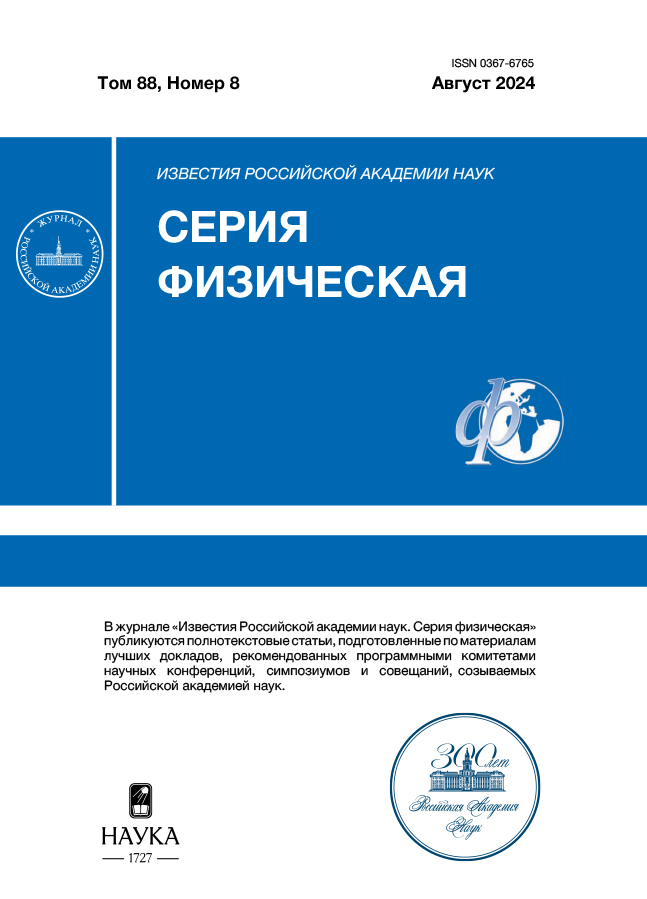Probing open charm production with ALICE-3 detector at high-luminosity Large Hadron Collider
- Autores: Malaev M.V.1,2, Riabov V.G.1,2
-
Afiliações:
- B. P. Konstantinov Petersburg Nuclear Physics Institute of the National Research Center “Kurchatov Institute”
- Moscow Institute of Physics and Technology
- Edição: Volume 88, Nº 8 (2024)
- Páginas: 1274-1279
- Seção: Fundamental problems and applications of physics of atomic nucleus
- URL: https://jdigitaldiagnostics.com/0367-6765/article/view/676753
- DOI: https://doi.org/10.31857/S0367676524080182
- EDN: https://elibrary.ru/OPRPFQ
- ID: 676753
Citar
Texto integral
Resumo
ALICE-3 is a future upgrade of the current ALICE experiment to be operated at high-luminosity Large Hadron Collider at CERN after 2030. One of the physics objectives of the experiment is to probe the hot and dense QCD matter produced in heavy-ion collisions via the measurement of open charm hadron production. The ALICE-3 detector is well equipped to measure production of ground and excited states of D-mesons in the decay channels with charged particles in the final state. In this presentation, we present results of feasibility studies for the measurement of open charm mesons in the decay channels with neutral photons or mesons by utilizing the large acceptance electromagnetic calorimeter.
Palavras-chave
Sobre autores
M. Malaev
B. P. Konstantinov Petersburg Nuclear Physics Institute of the National Research Center “Kurchatov Institute”; Moscow Institute of Physics and Technology
Autor responsável pela correspondência
Email: malaev_mv@pnpi.nrcki.ru
Rússia, Gatchina, 188300; Dolgoprudny, 141701
V. Riabov
B. P. Konstantinov Petersburg Nuclear Physics Institute of the National Research Center “Kurchatov Institute”; Moscow Institute of Physics and Technology
Email: malaev_mv@pnpi.nrcki.ru
Rússia, Gatchina, 188300; Dolgoprudny, 141701
Bibliografia
- Власников А.К., Жеребчевский В.И., Лазарева Т.В. // Изв. РАН. Сер. физ. 2021. Т. 85. № 5. С. 614; Vlasnikov A.K., Zherebchevsky V.I., Lazareva T.V. // Bull. Russ. Acad. Sci. Phys. 2021. V. 85. No. 5. P. 469.
- Laermann E., Philipsen O. // Annu. Rev. Nucl. Part. Sci. 2003. V. 53. P. 163.
- Иванищев Д.А., Котов Д.О., Малаев М.В. и др.// Изв. РАН. Сер. физ. 2021. Т. 85. № 12. С. 1800; Ivanishchev D.A., Kotov D.O., Malaev M.V. et al. // Bull. Russ. Acad. Sci. Phys. 2021. V. 85. No. 12. P. 1439.
- Adcox K., Adler S.S., Afanasiev S. et al. // Nucl. Phys. A. 2005. V. 757. P. 184.
- Wang Z.M., Aggarwal M.M, Ahammed Z. et al. // Nucl. Phys. A. 2005. V. 757. P. 102.
- Aamodt K., Abrahantes Quintana A., Achenbach R. et al. // JINST. 2008. V. 3. Art. No. S08002.
- Abelev B., Adam J., Adamová D. et al. // arXiv: 2211.02491. 2022.
- Жеребчевский В.И., Вечернин В.В., Иголкин С.Н. и др. // Изв. РАН. Сер. физ. 2021. Т. 85. № 5. С. 702; Zherebchevsky V.I., Vechernin V.V., Igolkin S.N. et al. // Bull. Russ. Acad. Sci. Phys. 2021. V. 85. No. 5. P. 541.
- Malaev M.V., Riabov V.G. // Particles. 2023. V. 6. No. 1. P. 364.
- Barnett R.M., Beringer J., Dahl O. et al. // Progr. Theor. Exp. Phys. 2020. V. 2020. Art. No. 083C01.
- Sjostrand T., Mrenna S., Skands P.Z. // Comput. Phys. Commun. 2008. V. 178. P. 852.
Arquivos suplementares










